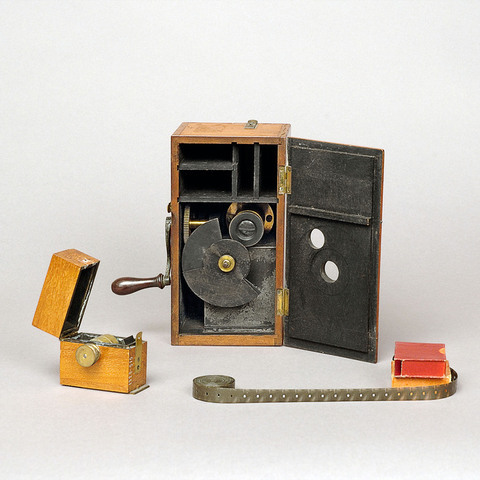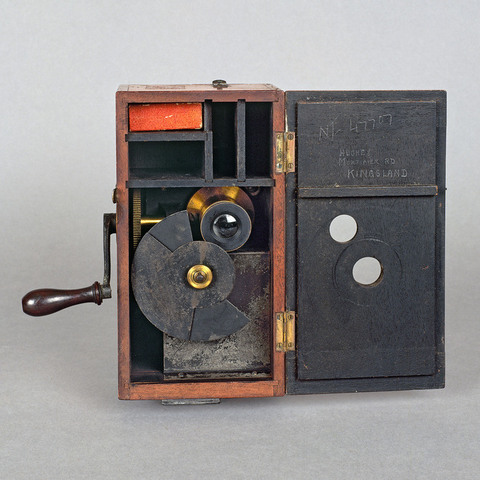Caméra réversible film 12,6 mm
Fiche détaillée
Type de l'appareil
entraînement du film 12,6 mm par une griffe ; came excentrique ; prise de vue image par image ; magasins en bois débiteur et récepteur ; obturateur réglable deux pales ; manivelle
Auteurs
Prestwich John Alfred
Londres, 744 High Road, Tottenham
Fabricants
Prestwich, John Alfred - Prestwich Manufacturing Company
Londres, 744 High Road, Tottenham
William Charles Hughes
Londres, Brewster House, 82 Mortimer Road
Utilisateurs
Prestwich John Alfred
Londres, 744 High Road, Tottenham
Distributeurs
William Charles Hughes
Brewster House, Mortimer Road Kingsland, Middlesex
Sujet du modèle
Informations non disponibles
Objectif
3 lentilles 1,5 cm Ø
Taille de l'objet
Ouvert :
Informations non disponibles
Fermé :
Longueur : 15.5 cm
Largeur : 17 cm
Hauteur : 20.5 cm
Diamètre :
Informations non disponibles
Taille de la boîte de transport
Informations non disponibles
Remarques
Le fabricant londonien William Hughes commercialise en 1899 la caméra réversible (prise de vue, tirage, projection) La Petite (ou La Petite Cinematograph). La pellicule mesure 12,6 mm et est perforée par un trou rectangulaire disposé entre chaque image. Un projecteur "La Petite Projector" est vendu vers 1900. La "Petite Living Picture Camera and Projector" est vendue £ 6,60 en 1899 puis £ 5,10 en 1900. Vendue avec une lanterne pour la projection.
"La Petite Living Picture Camera and Projector, aslo acts a snap-shot camera, a living picture camera, printer & projector in one, price £ 6,60, a superb piece of mechanism. [...] To popularize Animated Photography, and bring it within the reach of all, it has been necessary to produce an instrument at a moderate price, and at the same time reduce the cost of the sensitive film ; and again, of a design so simple, that any novice may feel confident with its manipulation. [...] La Petite is small, light, beautifully made and finished, and absolutely accurate, thereby producing results perfectly steady and without flicker. [...] Set the camera tripod on firm ground, so that it is perfectly rigid, and by means of a piece of plain matt celluloïd or oiled paper placed in the film case focus the object to be cinematographed ; the lens is focussed by turning it to left or right. Now open the front, and place the cardboard film box into the up-right recess, not on side. And pass the end of the film over the brass stay, then shut the door in front , turn camera round, then pass film through the race or cage, and again over the brass projector at the bottom of pressure plate, so that the end is outside. Then pass film into revolving box and attach the end of film to the hook on the brass revolving winder, then lock into position by the lever, care being taken not to buckle and catch the film in so doing. When this is ready stretch rubber band on to the pulley, and the machine is ready. The correct speed to turn the handle for all ordinary objects is two turns per second. If films are kept wound up for a long time before use, they must be rewound in the dark room, so that the reverse end is used" (Anonyme, La Petite Living Picture Camera and Projector, Londres, s.d., c. 1900).
"This it is smaller than the Birtac, and rather more solidly made than the Biokam. The camera is charged by means of a film supplied in a light-tight box. This can be done in ordinary light. The free end of the film is passed over a stay, through the race, and out at the back into a receiving box. On the handle being turned, as the film is paid out, it is wound up on a reel in the receiving box. [...] The procedure is ridiculously simple. [...] The film is clawed down in a similar way to the device used in the Biokam ; but instead of a slit being between each picture, in which the claw or peg engages, there is a square hole. This allows the safe passage of film which is not quite correctly perforated ; but the picture is consequently somewhat smaller. The film is wound into a small detachable receiving box. La Petite is made by Mr. W. C. Hughes, the well known optical specialist of Mortimer Street, Kingsland, and is splendid value for its cost, £ 5 10s." (Cecil M. Hepworth, Animated Photography, The ABC of the Cinematograph, London, Hazell, Watson & Viney, 1900, p. 125-127).
Bibliographie
H. Hopwood, Living Pictures, Londres, Optician & Photographic Trades Review, 1899, p. 170.
Cecil M. Hepworth, Animated Photography, The ABC of the Cinematograph, London, Hazell, Watson & Viney, 1900, p. 125-127.
J. Barnes, Filming the Boer War, Londres, Bishopsgate Press, 1992, pp. 110-113.
Anonyme, La Petite Living Picture Camera and Projector, Londres, s.d., (c. 1900).

